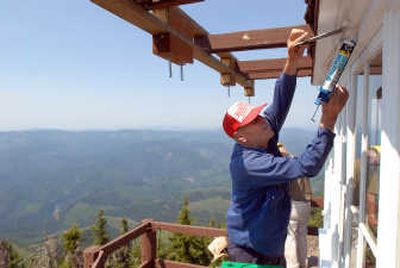Preserving fire towers

LITTLE GUARD LOOKOUT, Idaho – For most of the 20th century, this 6,000-foot perch served as a lighthouse of sorts over countless green miles of Panhandle backcountry.
In the days following an electrical storm, when wisps of smoke snaked up from smoldering logs on the forest floor, the lookout employee would mark the logbook and radio in the location.
Since the 1990s, Little Guard, like hundreds of other lookout towers across the West, were decommissioned and replaced by spotter planes. Now, the tower is rented by tourists for $35 a night and its logbook is filled with observations such as “Most amazing view of the Milky Way ever.”
Last week the tower was cleaned, painted and spruced up by a group of retired U.S. Forest Service smokejumpers. The parachuting firefighters once relied on lookout towers to guide them to fires. Now they’re working to make sure the structures don’t crumble and disappear from the landscape. The volunteer effort is part of a growing movement aimed at preserving the towers.
“They’re definitely of historical value,” said Ted Rieger, who was a smokejumper for three seasons in the early 1950s and later served as a district ranger in Idaho’s St. Joe River country. “They’re remnants of the old way.”
Rieger spoke while standing on the lookout’s catwalk, squirting caulk into cracks in the wooden siding. The tower has views up the North Fork Coeur d’Alene River Valley and across the Bitterroots, far into Montana. Rieger, who lives in Billings, appreciated the scenery but admitted he had no desire to pay to sleep in a lookout.
“Reminds me too much of work,” he said.
Although lookout towers might offer the best view from any bed this side of the Mississippi, many fans of the structures believe they should again be used as tools to fight wildfires. A handful of towers remain staffed in the Priest Lake and St. Joe River areas of North Idaho, but firefighting agencies now rely almost entirely on spotter aircraft and weather satellites to track fires.
Wildfires need to be churning out a lot of heat and smoke to be picked up by a satellite, said Ray Kresek, a Spokane resident and retired firefighter who runs a lookout tower museum at his home. Spotter planes are effective, but they only make a pass or two a day above the forest. Lightning-sparked fires might smolder unnoticed for days before sending out a puff of white smoke. By the time the plane makes another pass, the fire could be out of control.
“We’ve been the route of the air patrol being allegedly better; they just don’t see the area long enough,” said Kresek, who is also the author of “Fire Lookouts of the Northwest.”
Federal land managers are rethinking the wisdom of snuffing all wildfires, but as homes continue to be built in forested areas, the need for protection against wildfires is hardly vanishing. Kresek said the early detection abilities offered by lookouts offset their operational costs. A small fire, he noted, is much cheaper to fight. Over the past decade, the nation has spent an average of $911 million each year to fight wildfires, according to the U.S. Forest Service.
The recent lightning-sparked Tunk Grade fire in Okanogan County might have been stopped before it burned 17,000 acres had the nearby lookout tower remained in operation, Kresek suggested.
The Tunk Mountain tower is owned by Keith Argow, a retired Forest Service ranger and chairman of the Forest Fire Lookout Association.
The group is attempting to save as many towers as possible, said Argow, an Oregon native living in Virginia. “They are the lighthouses of the land; a sentinel of good forestry.”
For much of the 1990s, about one lookout tower a week was being dismantled or destroyed, Argow said. “Now it’s down to about one every 10 days.”
Idaho once operated 992 lookouts – the highest concentration in the world, according to Kresek’s research. The greatest density was probably in the St. Joe River drainage, where some lookouts were less than three miles apart.
Fewer than 200 remain standing, and only about 50 are actually used to spot fires.
Washington once had 658 lookout towers. Twenty-eight remain in operation, Kresek said.
A tower atop Mount Spokane was dismantled in 2001 and rebuilt for tourist rental on nearby Quartz Mountain. A tower on Stranger Mountain west of Chewelah is scheduled to be dismantled this summer, Kresek said.
Protecting remaining towers is not only a matter of preserving historical structures; Kresek believes the towers will again be valued as detection tools. “I see them coming back. It’s just a matter of time.”
The northern region of the Forest Service, which oversees North Idaho and Montana, has been working to preserve its remaining towers in recent years. Many of the towers, including Little Guard, were mass produced in Spokane and packed to peaks on the backs of mules, said Kirby Matthew, a Missoula-based Forest Service employee who specializes in the preservation of historical structures. The towers represent something of a minor engineering marvel, he said.
“It was a pretty-well- thought-out design,” he said. “They’re set on a peak. They get hurricane force winds on a monthly basis. Those buildings sit up there 70 years, and they don’t blow over.”
Standard issue in the towers was a chair designed to protect against electrocution. Glass insulators are attached to the base of the wooden chairs’ legs. “A friend of mine claims you can get five people standing on that chair during a storm,” Matthew said, laughing.